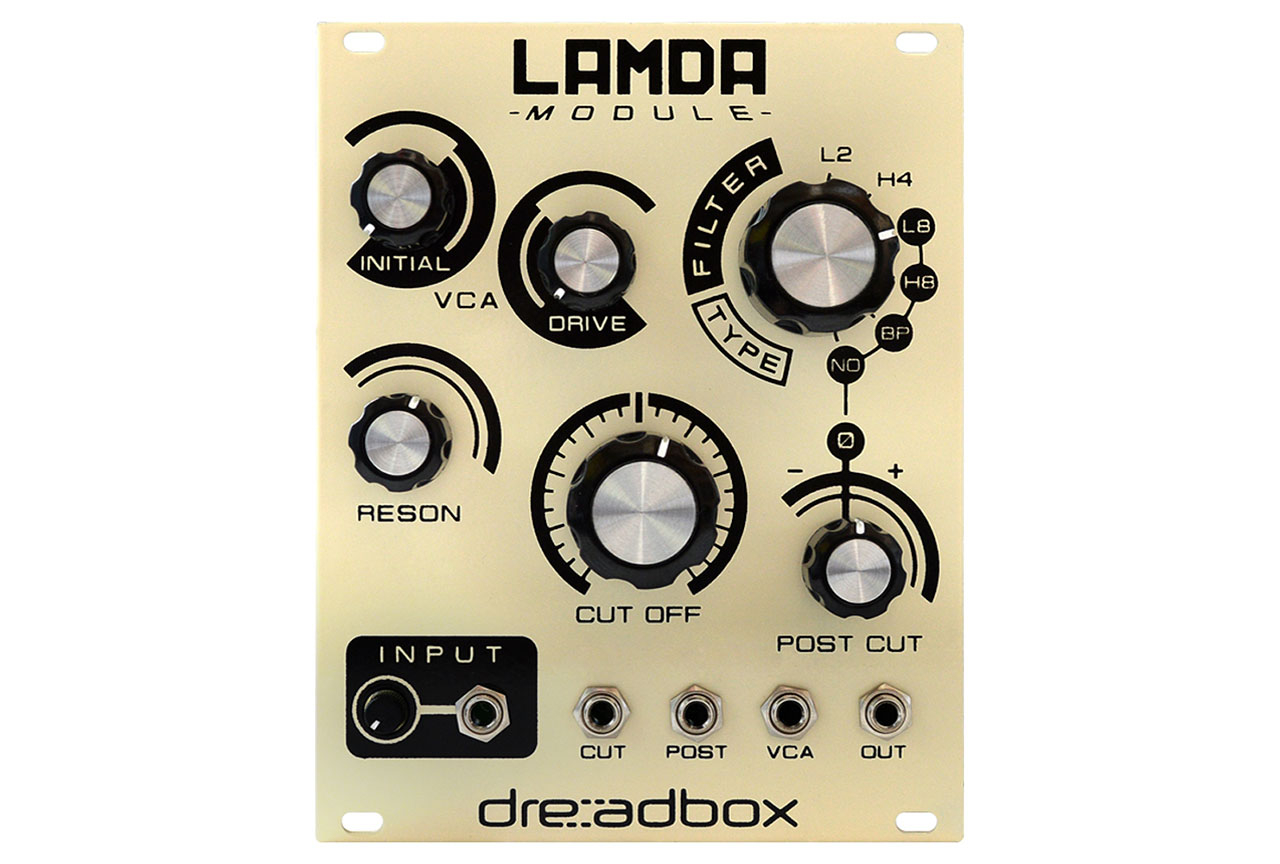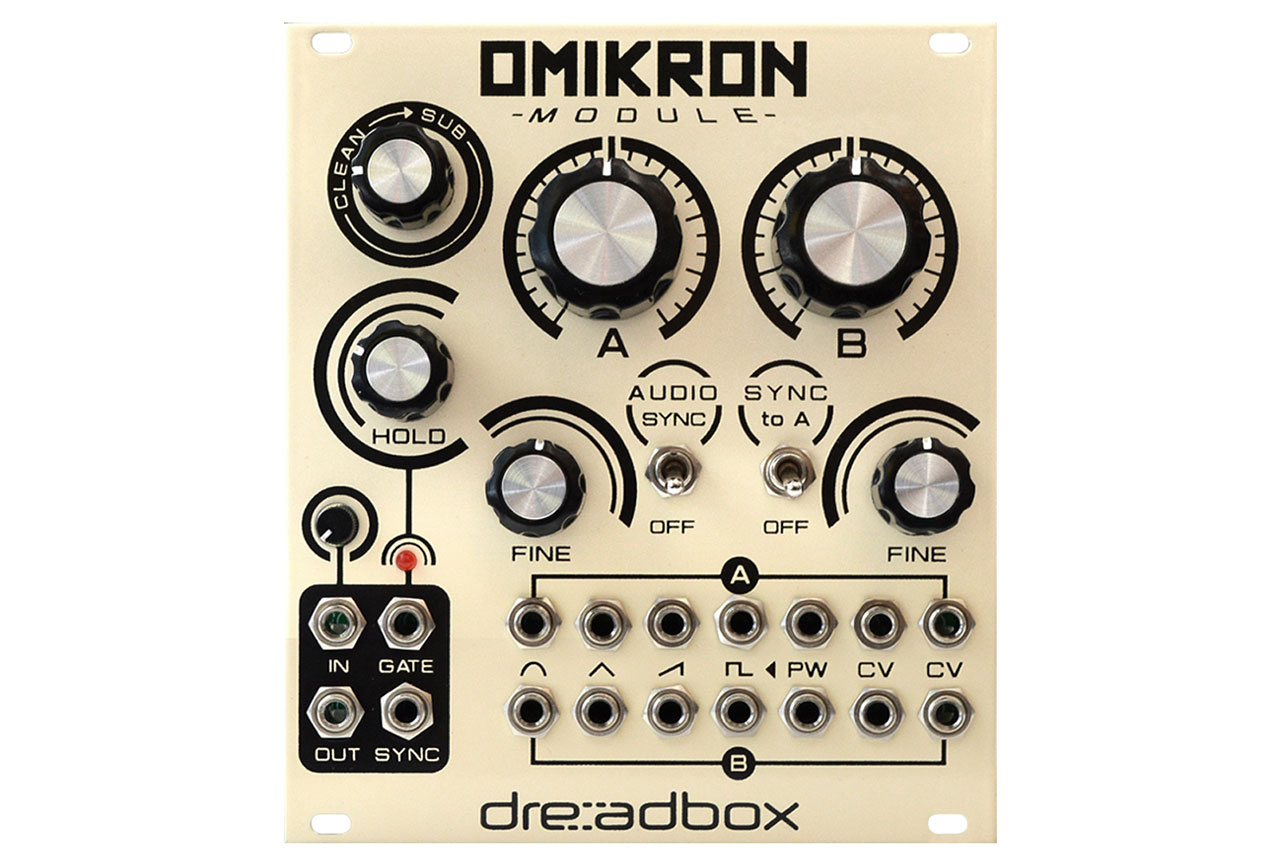- For a small, relatively under-the-radar company, Dreadbox has a remarkably strong identity. Its products have a sense of warm, rounded strength, emanating from both looks and sound. The semi-modular Erebus embodied this and packed a feature set that's at once straightforward and idiosyncratic, allowing it to be used as either a staple or an experimental device. (I bought the review model after my time with it, and it's now my favourite synth in my studio.) Dreadbox entered the modular market late last year, and the the system I tested contains six of their seven modules, making it a good place to gauge how the company's signature character translates to the Eurorack domain.
The Dreadbox modules are well built, and each of them offers a twist on basic functions. The Alpha is an envelope generator with two separate ADSRs that can be triggered individually. There's also a MIDI to CV/gate converter and two pitch CV outputs supporting paraphony, which is complemented by two 1V/octave pitch CV inputs on the main oscillator module, Omikron. It's two oscillators can be detuned against one another, outputting sine, triangle, saw or pulse waveforms. You can patch one into the other for frequency modulation, sync them together or sync oscillator A to an external audio source. That same source can also be underpinned with sub-bass and generate a gate or sync pulse. What's more, one of the oscillators can be used as that source, resulting in a range of possibilities.
The Lamda combines a filter and VCA, with CV inputs for cutoff, amplitude and a parameter called Post Cut. The filter offers two slopes each of low- and high-pass filters, a band-pass and notch filter. The Post Cut control can further shape the filter profile, with the effect depending on the filter type. The Delta is a delay module, which offers two delay paths with individual mix and feedback controls and individual delay times implemented as offsets against a central time control. The times are individually controllable with CV inputs, and the wet signals are also available as outputs. The delay times are quite short so it's best suited for chorus effects or to give a general sense of depth, although it does work for shorter rhythmic delays, too. The Theta is a dual LFO, sample-and-hold, clock and noise source module that offers useful modulation sources. However, it would've been nice if some of its controls, like the rates, were controllable with CV.
The two less conventional modules are coloured in black. The Ypsilon is a complex LFO with a combination of pulse, sine, sawtooth and two relatively unusual waveforms. There's also a rate CV input and a reset trigger, which can help make your LFO work rhythmically with other material. The final waveform produced by Ypsilon isn't wildly complex but it's certainly a step up from a basic LFO—plus, the basic waveforms are also available to patch, but they all run at the same rate. The Gamma is a sound generator that takes six VCOs and combines them in a way that sometimes sounds like unison—but more often like FM—depending on the position of the tune knob. A wide range of timbres can be produced from just the tune parameter and three switches labeled Harmonics. Expect dissonant tones, metallic textures and an experimental, random flavour of FM (this is partly due to the inability to precisely define the oscillator frequencies). This module also contains a simple filter and VCA, making it a straightforward, all-in-one sound source. The complete system comes encased in a sturdy 3U, 122HP Eurorack format case that also has a number of attenuators, a CV splitter and combiner, a mixer, an LFO and a master attenuator. There's also an illuminated wave graphic on the back panel, which pulses in time with the LFO. They advise you to only use Dreadbox modules in it, although I suspect this is a technical disclaimer rather than a commercial ploy.
All of this adds up to a system that's comfortable making straightforward patches, sounds deliciously thick and authentic yet doesn't feel restricted. Venturing to more experimental areas is natural and there are interesting options at each step of the patching process. The drive on the Lamda module enables heavy, imposing bass notes with a powerful squelch. The Theta and Gamma modules can be used as a basis for thick sample-and-hold FM burbles that don't have a hint of triteness about them. Theta's clock can be used to trigger envelopes in a 4/4 pattern, which can create interesting sub-grooves when combined with Ypsilon. Patching Gamma and Ypsilon together can result in abstract noisescapes that evolve and shift.
If you're going all-in for a full modular system, the other competitor in this price range is Doepfer. I'd say you're more likely to love the Dreadbox, though, thanks to its distinct personality. The price of the separate modules pushes the more expensive end of the scale but the complete systems are decent value (the case works out at £400-450 if you subtract the module prices). The price is justified in terms of build, sound quality and a combination of uniqueness and utility. Whether you want to buy a complete system from one manufacturer or build up a bespoke solution to your own personal requirements is up to you. I'd suggest that the former somewhat goes against the modular ethos but the Dreadbox solution is more distinct than most. Even if you go past purchasing a complete system, there are a number of modules here that could still take pride of place in a more varied system.
Ratings /
Cost: 3.6
Ease of use: 4.4
Versatility: 4.1
Sound: 4.6
Build: 4.2
 All of this adds up to a system that's comfortable making straightforward patches, sounds deliciously thick and authentic yet doesn't feel restricted. Venturing to more experimental areas is natural and there are interesting options at each step of the patching process. The drive on the Lamda module enables heavy, imposing bass notes with a powerful squelch. The Theta and Gamma modules can be used as a basis for thick sample-and-hold FM burbles that don't have a hint of triteness about them. Theta's clock can be used to trigger envelopes in a 4/4 pattern, which can create interesting sub-grooves when combined with Ypsilon. Patching Gamma and Ypsilon together can result in abstract noisescapes that evolve and shift. If you're going all-in for a full modular system, the other competitor in this price range is Doepfer. I'd say you're more likely to love the Dreadbox, though, thanks to its distinct personality. The price of the separate modules pushes the more expensive end of the scale but the complete systems are decent value (the case works out at £400-450 if you subtract the module prices). The price is justified in terms of build, sound quality and a combination of uniqueness and utility. Whether you want to buy a complete system from one manufacturer or build up a bespoke solution to your own personal requirements is up to you. I'd suggest that the former somewhat goes against the modular ethos but the Dreadbox solution is more distinct than most. Even if you go past purchasing a complete system, there are a number of modules here that could still take pride of place in a more varied system. Ratings / Cost: 3.6 Ease of use: 4.4 Versatility: 4.1 Sound: 4.6 Build: 4.2
All of this adds up to a system that's comfortable making straightforward patches, sounds deliciously thick and authentic yet doesn't feel restricted. Venturing to more experimental areas is natural and there are interesting options at each step of the patching process. The drive on the Lamda module enables heavy, imposing bass notes with a powerful squelch. The Theta and Gamma modules can be used as a basis for thick sample-and-hold FM burbles that don't have a hint of triteness about them. Theta's clock can be used to trigger envelopes in a 4/4 pattern, which can create interesting sub-grooves when combined with Ypsilon. Patching Gamma and Ypsilon together can result in abstract noisescapes that evolve and shift. If you're going all-in for a full modular system, the other competitor in this price range is Doepfer. I'd say you're more likely to love the Dreadbox, though, thanks to its distinct personality. The price of the separate modules pushes the more expensive end of the scale but the complete systems are decent value (the case works out at £400-450 if you subtract the module prices). The price is justified in terms of build, sound quality and a combination of uniqueness and utility. Whether you want to buy a complete system from one manufacturer or build up a bespoke solution to your own personal requirements is up to you. I'd suggest that the former somewhat goes against the modular ethos but the Dreadbox solution is more distinct than most. Even if you go past purchasing a complete system, there are a number of modules here that could still take pride of place in a more varied system. Ratings / Cost: 3.6 Ease of use: 4.4 Versatility: 4.1 Sound: 4.6 Build: 4.2